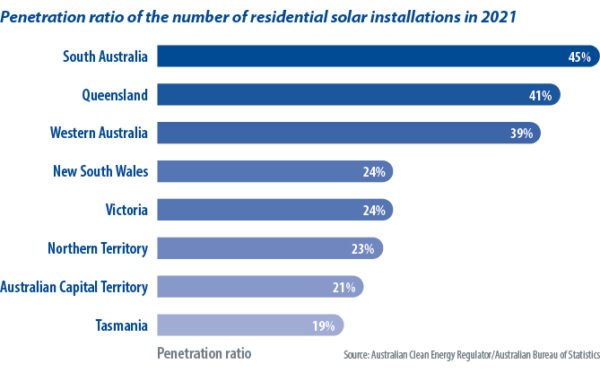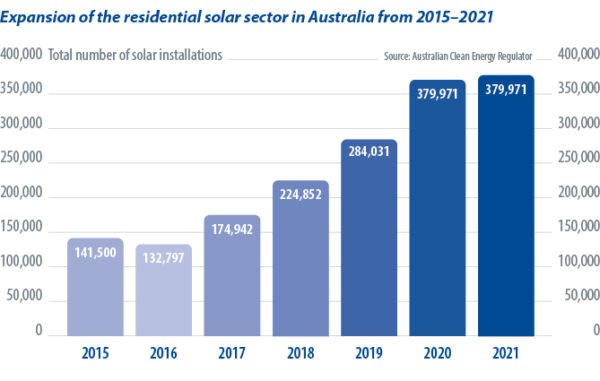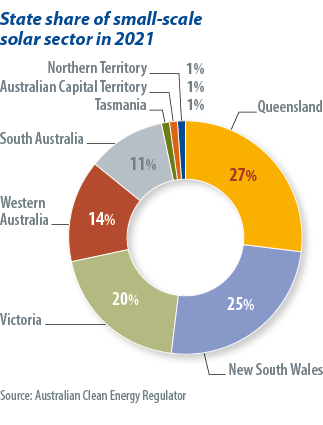From pv magazine ISSUE 09/23
In 2021, the Australian renewable energy industry contributed around 5% more of the nation’s electricity than in 2020. The proportion of Australian electricity generated from renewables increased from 16.9%, in 2017, to 32.2% last year.
Renewables have made Australia’s electrical infrastructure more cost-effective, dependable, and environmentally friendly. With Australians paying one of the world’s costliest home electricity rates, small-scale solar represented 24.9% of the nation’s renewables generation in 2021, and the nation added 3.3 GW of total solar capacity last year. Australian residential energy accounts for around 24% of power usage and around 11% of greenhouse gas emissions.
The residential solar boom and grid capacity constraints have driven sales of battery energy storage systems.
Small-scale solar
Rooftop, distributed-generation (DG) solar has expanded at a rate of 39% since 2017 and annual new small-solar records were smashed in almost every state in 2021, with an Australian total of 3.32 GW added, beating the 2.95 GW mark set in 2020. In 2021, New South Wales added 996 MW of new rooftop solar, Queensland 854 MW, Victoria 681 MW, and Western Australia 371 MW.
Key challenges
More than 3 million homes – one in four – have rooftop solar, with penetration of more than 45% in South Australia, which is expected to be the first of the state grids to meet all electricity demand from rooftop panels.
The rooftop boom, however, has brought three headaches: curtailment of excess solar power, the impact of decentralised generation on grids, and reduced feed-in tariff payments.
Curtailment woes
Grids intended for a one-way power supply to consumers suffer voltage variation and other power quality issues when rooftop solar energy is fed into them. The resulting curtailment means the grid’s net load falls more rapidly during the day, in turn ensuring that the evening ramp becomes steeper when there is no solar.
During the summer, the problem is exacerbated and some states have introduced regulations to remotely disconnect new or recently upgraded home arrays with inverter capacities of at least 5 kW.
This “last resort” move by utilities presently drives minimal curtailment but the wastage will worsen as home solar continues to gain in popularity – and that means less grid-payment income for people with solar roofs.
DG impact
If successfully planned by federal body the Australian Energy Market Operator (AEMO), the shift to decentralised generation could bolster energy system resilience, drive market competition to reduce wholesale energy costs, delay or avoid grid-expansion expenses, reduce grid-maintenance costs, and incentivise even more home solar in a virtuous cycle.

AEMO anticipates another 16 GW of sub-100 kW solar arrays by 2030. The use of batteries, virtual power plants (VPPs), and demand-response technology will be vital to ensure that grid electricity frequency and voltage stay within technical constraints, and that demand and supply are balanced.
The market operator is discussing VPP and demand-response and designing frameworks to co-ordinate the use of decentralised batteries, electric vehicle (EV) charging, and other methods offering grid load flexibility.
Role of batteries
Decentralised batteries, like rooftop solar, can reinforce grid stability by offering voltage and frequency management, and overload-mitigation. Correcting energy imbalances can defer costly grid infrastructure upgrades. Expensive batteries ensured that Australian rooftop solar pioneers did not usually opt for integrated home batteries at the same time, but the price of batteries is falling and device lifespans are lengthening.

As electricity prices continue to rise, batteries are becoming more attractive to households, with lithium-ion products dominating thanks to their technological maturity, modularity, and storage capacity.
Australia’s residential solar and storage market is in a phase of transition from the adoption of solar rooftops to the roll-out of energy storage. The role of consumers in accelerating the energy transition is key. As cost is the limiting factor for household batteries, the building of community-scale storage systems could be one solution for reducing capital investment and ensuring economies of scale.
Battery energy storage serves as a means to maximise the value of residential solar installations. Batteries can perform peak load control to incorporate variable and renewable power generation into the grid, or they can offer home load-shifting of energy from the daytime (when solar generation is abundant) to the evening. In addition, batteries can provide grid stabilisation services, such as the aforementioned frequency and voltage control, and can help utilities to save money by obviating the need to extend power lines. The optimal efficiency of utility grids involves both battery storage and, when necessary, curtailment.

Considering these facts, it is necessary to develop regulations that support and create win-win scenarios for both energy consumers and utilities. Curtailment must decrease as the storage capacity of installed batteries increases. Economically, residential batteries are preferable to any major changes to utility infrastructure. Solar curtailment may be economically more advantageous but its acceptability to the public may be doubtful, in a wider context.
Integrated approach
Australia is already deploying batteries and grid management, VPPs, increased connectivity, and demand-response to ensure that grid stability is maintained and the former play an important role in grid management and mitigation.
Small-scale batteries can be used for residential purposes during peak demand at night, to avoid high electricity prices. Batteries, as we have seen, can offer stability to grids as electricity is absorbed or dispatched rapidly and stored energy is released during periods of high demand. Batteries are often employed for small-duration grid interventions.
 Legislation adopted by Western Australia in 2020 permits the use of standalone power systems to serve rural and otherwise isolated customers. The Western Australian government developed a policy to permit the use of neighbourhood batteries which enable consumers to store excess solar energy produced during the day and use it at night or share it with their neighbours. Western Australia was the first state in Australia to implement such policies, making it a pioneer in exploring the possibilities that are likely to be presented by a distributed-energy future.
Legislation adopted by Western Australia in 2020 permits the use of standalone power systems to serve rural and otherwise isolated customers. The Western Australian government developed a policy to permit the use of neighbourhood batteries which enable consumers to store excess solar energy produced during the day and use it at night or share it with their neighbours. Western Australia was the first state in Australia to implement such policies, making it a pioneer in exploring the possibilities that are likely to be presented by a distributed-energy future.
The number of concurrent installations of residential solar systems with batteries is on a steady increase. A more interconnected grid provides access to more affordable resources, realises the benefits of diversity from several energy sources in different places with varying generation profiles, and enables improved resource usage across the electricity market.
Managing the transition
Despite the fact that the residential battery market is still in its infancy, the technology itself is now on the verge of a sharp price decline.
Failure to proactively manage battery integration into grids with escalating home storage adoption rates might result in major supply chain inefficiency, such as a drop in infrastructure utilisation, asset deterioration, increases in electricity costs, and larger societal and economic inefficiencies.
The economic and non-financial reasons motivating consumers to install residential battery systems are altering the current power supply system’s demand and load profile. In turn, this will alter market dynamics, causing existing supply chain participants to respond strategically.
Sustained market penetration, and the future impact of battery storage, will be influenced by adoption patterns, the entrance of new players to the market, and the extent to which policymakers intervene to promote socially useful consequences.
The socio-technical transition of the energy system is likely to occur in Australia despite differences in the power system.
However, intelligent and equitable policy measures are required to expedite such a transition and advance solar technology.
 About the author: Nikhil Jayaraj is the managing director of Regen Power Pty. Ltd. He is a seasoned manager who has bootstrapped his business in the renewable and energy market in Western Australia. He has more than 13 years’ experience in grid and off-grid solar sales management, with a specialisation in residential, commercial, off-grid and solar farm projects. He is now pursuing a doctorate of business administration at Curtin University.
About the author: Nikhil Jayaraj is the managing director of Regen Power Pty. Ltd. He is a seasoned manager who has bootstrapped his business in the renewable and energy market in Western Australia. He has more than 13 years’ experience in grid and off-grid solar sales management, with a specialisation in residential, commercial, off-grid and solar farm projects. He is now pursuing a doctorate of business administration at Curtin University.
This content is protected by copyright and may not be reused. If you want to cooperate with us and would like to reuse some of our content, please contact: editors@pv-magazine.com.








1 comment
By submitting this form you agree to pv magazine using your data for the purposes of publishing your comment.
Your personal data will only be disclosed or otherwise transmitted to third parties for the purposes of spam filtering or if this is necessary for technical maintenance of the website. Any other transfer to third parties will not take place unless this is justified on the basis of applicable data protection regulations or if pv magazine is legally obliged to do so.
You may revoke this consent at any time with effect for the future, in which case your personal data will be deleted immediately. Otherwise, your data will be deleted if pv magazine has processed your request or the purpose of data storage is fulfilled.
Further information on data privacy can be found in our Data Protection Policy.